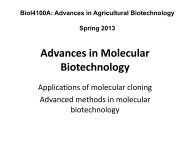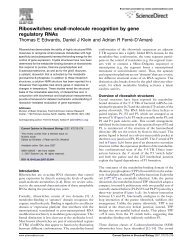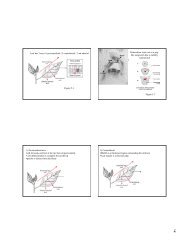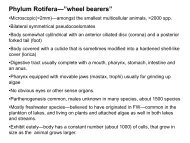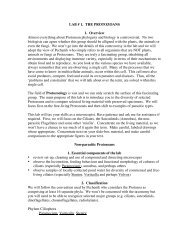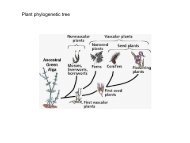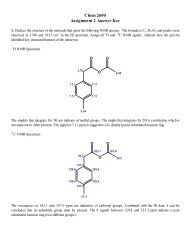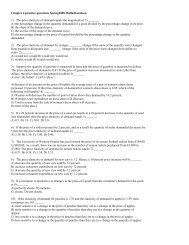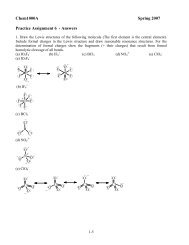Lecture 10
Lecture 10
Lecture 10
You also want an ePaper? Increase the reach of your titles
YUMPU automatically turns print PDFs into web optimized ePapers that Google loves.
Chlamydomonas, unicellular biflagellate<br />
Volvox, colonial flagellate,<br />
gelatinous matrix<br />
Chlorophyta—green algae<br />
•Nucleate,<br />
•pigments contained within chloroplasts,<br />
•vacuoles present,<br />
•chloroplasts grass green (chlorophylls a & b)<br />
•food stored as starches,<br />
•cell wall of cellulose,<br />
•mostly microscopic, some flagellate,<br />
•some filamentous and some macrophytic<br />
species<br />
(1a)Flagellate(2)<br />
(2a) Not flagellate(3)<br />
(2a)unicellular, flagellate, with a cell wall<br />
Eg Chlamydomonas<br />
(2b) colonial, flagellated, with a gelatinous<br />
matrix<br />
Eg Volvox
(3a). Unicellular (4)<br />
(3b) Colonial (5)<br />
(4a)with a median constriction—Desmids<br />
(4b) without a median constriction<br />
Staurastrum<br />
40 microns<br />
Common in the plankton of lakes and ponds
Tetmemorus<br />
Micrasterias<br />
Closterium spp.<br />
40 microns<br />
Common in the plankton of<br />
lakes and ponds
(4b) Cells without a median constriction—cells arcuate in shape,generally in a<br />
loosely assembled colony--Ankistrodesmus<br />
Cells<br />
30-40<br />
Microns<br />
Long<br />
A very<br />
Common<br />
And<br />
Edible<br />
Species<br />
In the<br />
Phyto-<br />
Plankton<br />
of lakes<br />
and ponds
(5a) Colonies microscopic (6)<br />
(5b) Colonies macroscopic or filamentous (7)<br />
(6a) Colony a flat plateof radiately attached cells –Pediastrum<br />
50 microns<br />
Common in the<br />
Phytoplankton of<br />
Lakes and ponds
(6b) Colonies composed of lunate, sausage-shaped or curved cylindrical cells<br />
laterally united, terminal cells often with spinous projections--Scenedesmus<br />
Cells 20-30 microns<br />
across
(7a) Colony a macroscopic net-like sac<br />
Hydrodictyon<br />
Hydrodictyon—chlorophyta—a meshlike bag of made formed by<br />
cylindrical cells—its name means “water net”<br />
The colony can be several cm in size. Blooms of Hydrodictyon can<br />
dominate the plankton in eutrophic lakes, it is inedible to<br />
zooplankton and other consumers
(7b) Cells connected end to end in filaments<br />
(8a) filaments not branched eg. Spirogyra, Oedogonium<br />
70 microns
(8b) Filaments branched eg Cladophora or Stigeoclonium<br />
500 microns<br />
Cladophora
Chara –-the stonewort<br />
A macrophytic<br />
Green alga
Ecology of Chlorophyta<br />
•Few other algae have such a wide range of distribution and abundance as<br />
chlorophyta<br />
•Many even live in soils, and some grow on snow (red snow)<br />
•Very important primary producers in the plankton of lakes, ponds, rivers and<br />
streams—less important in oceans and esturaries.<br />
•Smaller forms tend to be planktonic, whereas the larger filamentous forms usually<br />
grow attached to surfaces such as rocks or other hard substrates.<br />
•Many of the smaller filamentous green algae grow epiphytically on larger ones or<br />
on aquatic macrophytes.<br />
•Some grow mainly on, or within the tissues of animals as symbionts<br />
•They are considered to be the ancestors of all higher plants (charophytes)<br />
•They can form dense blooms in nutrient-rich waters.<br />
•They are usually not toxic to animals, and are often very important nutritionally<br />
•Some however, do cause taste and odour problems in water supplies.
Bacillariophyta—the diatoms<br />
•thick bivalved ornate cell wall made of<br />
silica (glass),<br />
•Nucleate(1), vacuoles present,<br />
•pigments contained within chloroplasts,<br />
chloroplasts brownish (chlorophyll a plus<br />
accessory carotenoids),<br />
•food stored as oils,<br />
•single celled (elongate or round) although<br />
sometimes joined side-by-side or end-toend<br />
as filaments<br />
Some essential terminology<br />
fr—frustule, cn—central nodule, r—raphe,<br />
p—punctae, s—striae, c--costa<br />
Valve view, girdle view<br />
Pennate and centric forms
Diatom in valve view<br />
Central area<br />
Central nodule<br />
raphe<br />
stria<br />
Terminal<br />
nodule
Abbreviated diatom key<br />
(1a)Pennate (2)<br />
(1b)Centric or filamentous (14)<br />
(2a) valves without a raphe (3)<br />
(2b) with raphe (8)<br />
(3a) with septa apparent in girdle view eg Tabellaria<br />
(3b) without septa in girdle view (4)<br />
(4a) valves with large costae in valve view (5),<br />
(4b) valves without costae (6),<br />
(5a) valves symmetrical to transverse axis Diatoma,<br />
(5b) valves asymmetrical to transverse axis Meridion<br />
(6a) valves symmetrical to transverse axis, not forming star-shaped colonies (7)<br />
(6b) valves asymetrical to transverse axis, frustules forming star-shaped colonies--<br />
Asterionella<br />
(7a) frustules forming side-by-side colonies usually seen in girdle view eg Fragilaria<br />
(7b) frustules not forming colonies, often seen in valve view eg Synedra<br />
(8a)Valve symmetrical to both longitudinal and transverse axis (9)<br />
(8b)Valve asymmetrical to either axis(12)
(9a)Frustule sigmoid, striae fine—Gyrosigma<br />
(9b)Frustule not sigmoid, striae costate appearing as ribs(<strong>10</strong>)<br />
(<strong>10</strong>a) raphe appearing as a wavy line, central area confined to a small nodule—Pinnularia<br />
(<strong>10</strong>b) raphe appearing straight (11)<br />
(11a) central area extending about half way to lateral margin of the valve—Navicula<br />
(11b) central area very wide extending to valve margin--Stauroneis<br />
(12a) Valve asymmetrical to transverse axis—eg Gomphoneis<br />
(12b) Valve asymmetrical to longitudinal axis (13)<br />
(13a) raphe fairly close to ventral margin, without distinct terminal fissures—Amphora<br />
(13b) raphe closer to midline, with distinct terminal fissures—Cymbella<br />
(14a)Frustules forming long filaments, cells seen in girdle view, girdle conspicuous joined<br />
to valve mantle by a conspicuous groove—Melosira<br />
(14b)valves circular or radially symmetrical, usually seen from valve view, margin of valve<br />
marked by coarse costae or fine striae—Eg Cyclotella or Stephanodiscus
Usually found attached to rocks--periphyton
Usually found attached to rocks--periphyton
Meridion<br />
Costae evident in valve view<br />
Usually found in periphyton or as epiphytes<br />
On macrophytes or filamentous green algae
Fragilaria colony cells joined side-by-side<br />
in girdle view, generally planktonic<br />
Valve view (on the left)<br />
Each cell 50-70 microns
Synedra<br />
Abundant in periphyton<br />
About <strong>10</strong>0 microns long
Asterionella<br />
Fairly large for planktonic diatoms<br />
Each spoke around 50-70 microns<br />
Commonly found in dense blooms<br />
during May, prior to the onset of<br />
thermal stratification
Gyrosigma<br />
Around <strong>10</strong>0 microns long<br />
Abundant in periphyton
Pinnularia about <strong>10</strong>0 microns<br />
Abundant in periphyton
Navicula<br />
Abundant in periphyton
Abundant in<br />
periphyton
Gomphoneis<br />
Abundant in periphyton
Melosira<br />
A filamentous diatom-each cell around 20 microns long<br />
In the phytoplankton of lakes in the spring, but sink rapidly into the<br />
hypolimnion during the summer months<br />
Some species grow attached to rocks in streams
Cyclotella (around 20 microns) and Stephanodiscus (around 50 microns)<br />
Usually abundant in spring plankton
Ecology of diatoms<br />
•Extremely important primary producers in lake and ocean phytoplankton, and<br />
in the benthic algal communities of lakes and streams.<br />
•Species that have a raphe are able to move slowly around 0.2-25/sec. This is<br />
very slow, and with their siliceous frustules they tend to sink rapidly, unless<br />
they have elaborate cell extensions.<br />
•Diatoms often form dense blooms in silica rich cold waters, mainly spring and<br />
fall, when the water column is well-mixed<br />
•Many species are extremely edible to small animals and are an important<br />
source of nutrition for them<br />
•Most diatom species have narrow limits of tolerance and preference for<br />
chemical conditions in the water example, pH, alkalinity, salinity, Ca, P, N,<br />
organic matter, pollutants of various kinds, as well as temperature.<br />
•This, together with the fact that diatoms are so abundant and preserve well in<br />
sediment cores, makes diatoms very useful as indicators in paleolimnology.
Epiphytic diatoms
Asterionella<br />
A planktonic diatom—blooms<br />
in early spring in oligotrophic<br />
and mesotrophic lakes
A variety of pennate diatoms<br />
Most grow attached to rocks<br />
and other hard substrates in<br />
streams or along lakeshores




